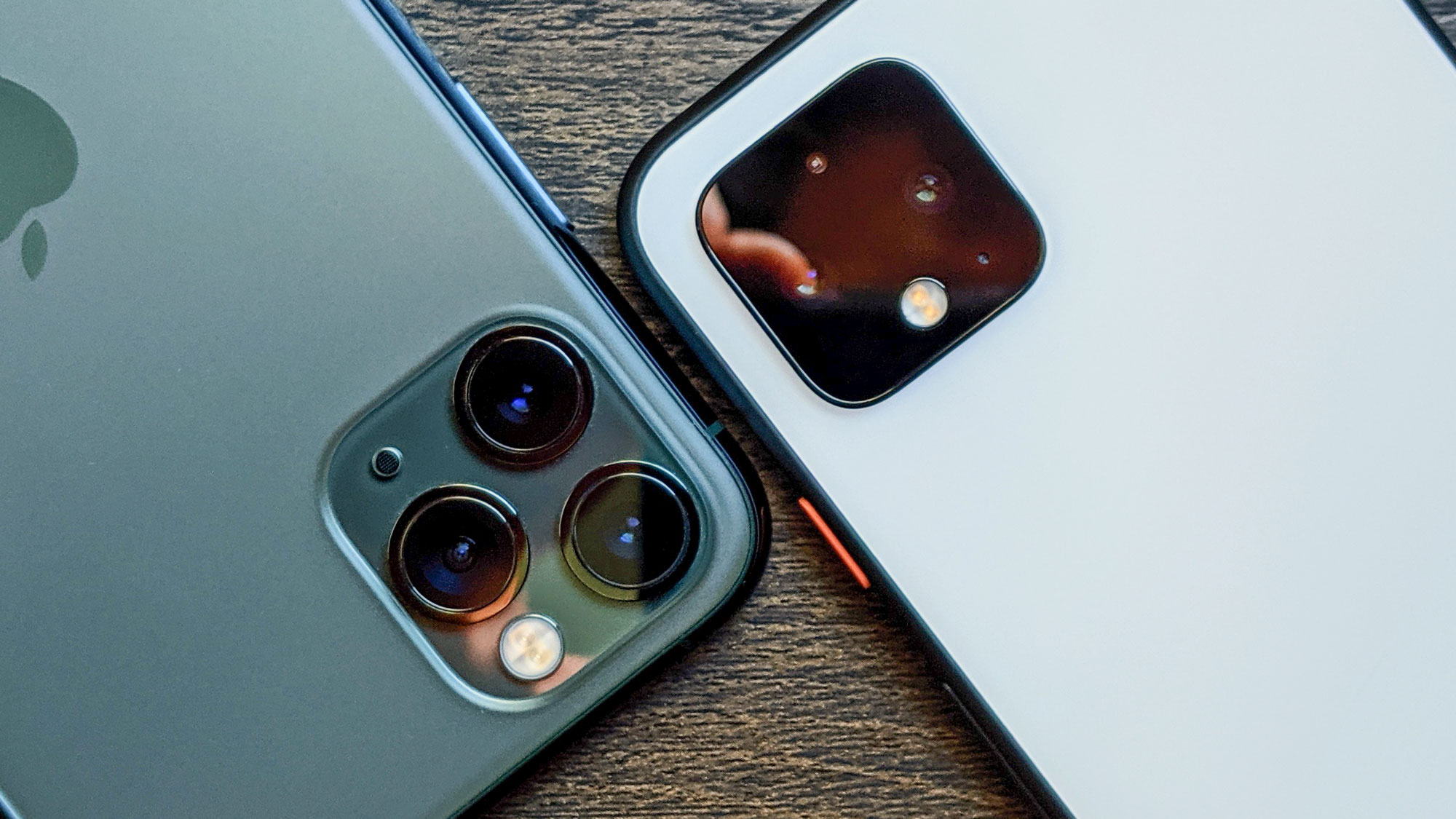Pixel 4 vs iPhone 11 Pro Camera Face-Off: Why Apple Wins
Spoiler: It's all about versatility

Is a good smartphone camera about computational photography mad science, or just physics? That’s the question Apple and Google are asking with their two latest flagship phones, which also happen to be the best camera phones we’ve ever tested: the iPhone 11 Pro and Pixel 4.
From both hardware and software perspectives, the two phones are quite different. (You can get an idea of just how different in our Pixel 4 vs. iPhone 11 Pro comparison.) The Pixel 4 has two cameras on the back, one of them being a new 16-megapixel, ƒ/2.4 telephoto lens that starts at 2x zoom, but can go up to 8x with limited loss in quality using Google’s Super Res Zoom technology.
The iPhone 11 Pro, meanwhile, has an ultrawide lens in addition to the standard wide and telephoto optics, allowing you to pull out and fit more into a scene. Apple’s mobile camera has also recently been improved with the help of a new Deep Fusion mode issued in a post-release update, specifically designed for medium-lighting scenarios.
We snapped a multitude of pictures with both handsets to determine a winner. Here’s what we found.
Statue
We begin in Bryant Park, where the Pixel 4 and iPhone 11 Pro delivered strikingly different interpretations of the same scene. These images don’t look like they were captured at the same time, but the iPhone’s photo is significantly warmer, while the Pixel’s is more true to the actual, cloudy conditions at the time. I like the relative sharpness of the shot from the iPhone, though the deeper shadows and contrast of the Pixel’s take are superior in those respects.
So which is better? That all depends on what you’re after — realism, or the photo you’re more likely to want to share on Instagram. If we’re basing this decision on the former, it’s a clear win for the Pixel 4. But if we’re going on the latter — as I suspect most people would — the iPhone 11 Pro comes away with the win.
Winner: iPhone 11 Pro
Park at night
We returned to Bryant Park at a much later time to snap a couple more photos, using each phone’s respective night mode. Again, the iPhone 11 Pro skews warm — it has a tendency to do that, these trials have shown us — while the Pixel 4 better exposes all the little details, from the trees, to the leaves in the sky to the windows on the buildings across the street.
To Apple’s credit, the iPhone 11 Pro is a bit better at isolating the lights from the park lamps and keeping them from being blown out too aggressively. But the Pixel 4’s Night Sight teases a striking degree of visibility out of this image — something we also noted in our Pixel 4 review — which is what you ultimately want out of such a feature.
Winner: Pixel 4
Person at night
For a more challenging night shot, my colleague Caitlin had her photo taken under the shadows of trees on a sidewalk in stark darkness, save for lights from buildings and street lamps in the background. Neither phone truly conveys how dim the conditions actually were — they both make it look like a dusk scene — but the iPhone 11 Pro gets more right.
Apple’s phone nails the sharpness of the ground and surrounding objects, and manages the highlights better. In fact, you only could argue the Pixel 4 is superior is with regard to Caitlin herself — she’s a bit blurry in the shot from Google’s phone, but sharper overall, with more contrast in her face.
Winner: iPhone 11 Pro
Street sign
These images, captured using the Pixel 4 and iPhone 11 Pro’s respective 2x optical zooms, highlight yet more significant differences between Google’s and Apple’s approaches to photography. If you look closely, you’ll notice that the iPhone’s version of the scene is a bit noisy — something especially visible when looking at solid colors, like the green of the street signs themselves, and the sky above. But the Pixel 4 aggressively stamps out this noise, which has the downside of curtailing sharpness.
As such, certain details, like the way light gleams off the side of the screws that hold the pole together, just aren’t as present on the photo taken with the Pixel 4. Everything is darker, too, and you lose the distinction between the bricks comprising the building immediately to the left. For all these reasons, the iPhone wins out here.
Winner: iPhone 11 Pro
Library
This Pixel 4 shot was the one from Google’s phone that impressed me the most. The iPhone 11 Pro tries too hard to brighten shadows in the corners of the room, which consequently leads to a flatter image across the board. Conversely, Google’s phone knows exactly how to light this scene, and is able to ramp out the exposure just enough to bring out the cherry tones of the walls, without going so far as the blow out the candles and the light breaking through from the window above.
Winner: Pixel 4
Portrait
I always like using my colleague Henry in Portrait Mode photo comparisons, because his clear eyeglass frames trip up literally every phone maker’s stereoscopic vision system. The same is true here, as both the Pixel 4 and iPhone 11 Pro fail to differentiate the right edge of his glasses from the background.
However, in most other respects, the picture taken with Apple’s device is superior. The iPhone retains more color in Henry’s face, but doesn’t sharpen his complexion as harshly, or play up the shadows in as heavy handed and painterly a way. His button-down shirt is more of a lavender than the blue that the Pixel would have you believe, too.
Winner: iPhone 11 Pro
8X Zoom
If you’re looking for proof that Google’s Super Res Zoom technology is the real deal, just look at the above shot of a skyscraper taken using the Pixel 4 at 8x power. The iPhone 11 Pro doesn’t benefit from the same algorithms, so its result is grainier and blurrier compared to the Pixel’s, which looks so clean, you’d be forgiven for believing it was captured with purely optical zoom.
Winner: Pixel 4
Ultrawide
This isn’t much of a surprise, but it only seemed fair to do after a test that put Super Res Zoom front and center. If we’re going to evaluate what these cameras can do across the board, we have to take into account the iPhone 11 Pro’s ultrawide lens, which can include so much more within a frame than the Pixel 4’s standard wide-angle optics can.
Personally, I’m not much of a believer in the ultrawide craze; given the choice, I’d rather have a telephoto, as most of the time I find myself limited by an inability to zoom in, rather than zoom out. But the iPhone 11 Pro, as well as the cheaper iPhone 11, gives you the ability to do both — and that makes Apple’s phone more versatile.
Winner: iPhone 11 Pro
Overall winner: iPhone 11 Pro
The Pixel 4 has some of the finest cameras on any phone, and in some scenarios — like when zooming from afar — they’re better than Apple’s. But most of the time, the iPhone 11 Pro wins out.
| Header Cell - Column 0 | Google Pixel 4 | iPhone 11 Pro |
|---|---|---|
| Statue | Row 0 - Cell 1 | X |
| Park at night | X | Row 1 - Cell 2 |
| Person at night | Row 2 - Cell 1 | X |
| Street sign | Row 3 - Cell 1 | X |
| Library | X | Row 4 - Cell 2 |
| Portrait | Row 5 - Cell 1 | X |
| 8X Zoom | X | Row 6 - Cell 2 |
| Ultrawide | Row 7 - Cell 1 | X |
| Total | 3 | 5 |
Apple’s computational photography favors warmer images with less contrast. While that isn’t preferable in every photo op, as this faceoff demonstrates, the results are often sharper than the Pixel 4’s with better treatment of highlights and more detail in the shadows. The inclusion of an ultrawide lens on the iPhone 11 Pro also unlocks further opportunities to capture your surroundings from a unique perspective. And Apple’s low-light capabilities removes an edge Google used to enjoy over the competition.
If there’s one particular area in which Google has an advantage though, it’s with respect to zoom. The Pixel 4’s Super Res Zoom technology will let you draw closer than you’d ever dream to with a smartphone. That makes the Pixel 4 the perfect phone for all the situations where you want to snap a pic, but the subject of interest is just a bit too distant. For everything else, though — from shallow depth-of-field portraits to night shots — the iPhone 11 Pro is just a bit more well-rounded.
Get instant access to breaking news, the hottest reviews, great deals and helpful tips.
Adam Ismail is a staff writer at Jalopnik and previously worked on Tom's Guide covering smartphones, car tech and gaming. His love for all things mobile began with the original Motorola Droid; since then he’s owned a variety of Android and iOS-powered handsets, refusing to stay loyal to one platform. His work has also appeared on Digital Trends and GTPlanet. When he’s not fiddling with the latest devices, he’s at an indie pop show, recording a podcast or playing Sega Dreamcast.
